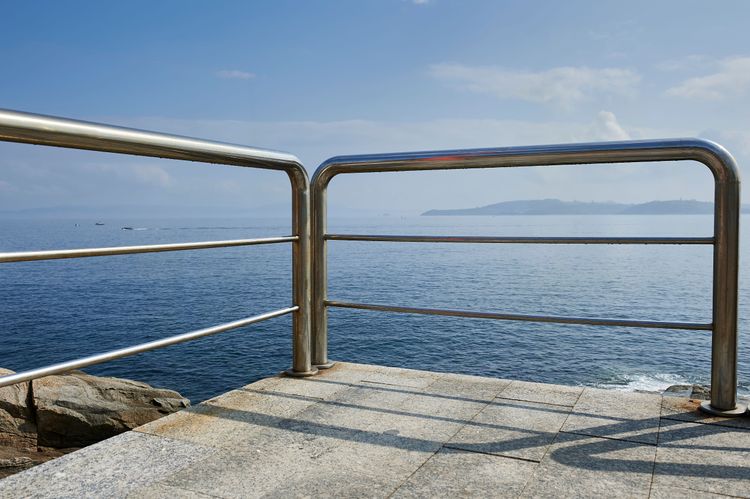1. Docks - Stainless steel is widely used in the construction and operation of docks and marinas for recreational and commercial purposes. Grade 316, also known as marine-grade stainless steel, is commonly used in these applications for structural and decorative purposes.
Stainless steel can provide internal support for dock structures using blind bolts, thru-rods, washers, nuts, and bolts, regardless of the materials used. In addition, stainless steel can be used for various surface elements such as trim, flooring slats, handrails, supports, and decorative tags or signage.
2. Stainless steel ship and boat components - Stainless steel is a popular choice of metal for various components in ships and boats, from large commercial freighters on the ocean to small pontoon boats on the lake. It can be found in various applications, including but not limited to piping, pulpits, hinges, propeller shafts, railings, accents, fasteners, and shackles.
Stainless steel piping is becoming more popular in new ship builds as a substitute for painted carbon piping. Compared to carbon piping alternatives, stainless piping does not require a second painting process, resulting in time and installation cost savings. Furthermore, its enhanced durability and reduced maintenance result in lower lifetime operational costs.
Stainless steel is used in small components and larger items such as hull plates, engine room components, masts, and stacks, depending on the vessel's design.
Selecting the appropriate grade of stainless steel for each component is essential to achieve an optimal balance between corrosion resistance, performance, and cost that satisfies safety and budgetary requirements, similar to most stainless steel items.
3. Offshore platforms - Offshore platforms present extremely challenging conditions for metal parts and components due to constant exposure to the elements, forces from different directions, and saltwater corrosion. These factors increase the risk of corrosion and component degradation, posing a significant threat to safety and structural integrity. Moreover, offshore platforms are often remote, towering hundreds of feet above the water and weighing several tons.
Therefore, component failure can result in catastrophic consequences. To combat these challenges, stainless steel is an ideal material that solves most of these issues. It finds extensive use in offshore platforms, from larger structural supports and catwalks to smaller components such as handrails, platforms, and signage.
How to choose stainless steel for your application?
To select the most suitable stainless steel products for your specific requirements, it is crucial to have a comprehensive understanding of regulatory obligations, metallurgical properties, and other relevant details. The subsequent factors can help you narrow down your choices.
1. Chloride presence - Selecting suitable grades of alloys is crucial for components used in freshwater or saltwater settings. Opting for ideal grades like Grade 316 or 316L stainless steel will enhance the lifespan of critical components and ensure operational safety.
Although 304/304L stainless steel components may initially be cheaper than 316/316L parts and components, adding molybdenum to 316/316L's chromium-nickel austenitic grain results in significantly lower lifetime ownership costs, particularly in wet or chloride-rich environments commonly found in marine applications.
2.Ambient Temperatures – Although stainless steel is generally known for its excellent performance in various temperatures, it is essential to consider the specific use environment, especially in extremely hot or cold conditions.
3.Water clarity and cleanliness – Selecting the appropriate grade of stainless steel for piping, flanges, and other components is crucial when dealing with fluids containing suspended solids, contaminants, or abrasive properties, as they pose unique challenges and corrosion risks. It is essential to consider any factors that may impact performance, such as blocked valves and gates or microbial corrosion.
4.Water Pressure - It is essential to comprehend the effects of water pressure and movement when selecting stainless steel piping products. The structural strength and pressure ratings of these products vary significantly. However, considering factors such as processing flow directions, stagnant areas, and other elements related to the movements within the system is crucial to prevent additional risks like crevice corrosion.
Various types of stainless steel in marine applications and their advantages
Different types of stainless steel have various benefits and purposes. Here are some examples:
1. 304 stainless steel is suitable for coastal service environments, splash zone applications, and intermittent submersion in seawater. It is often used for fully exposed components that are frequently washed with fresh water.
2. Super-austenitic stainless steels such as 6% moly are recommended for applications where they will be permanently submerged in seawater. These alloys contain at least 6% molybdenum and have exceptional resistance to a variety of chemicals, making them suitable for environments like brackish water, seawater, and pulp mill bleach plants that have high chloride conditions.
3. Duplex stainless steels (e.g., ASTM S31803) have higher strength, meaning lighter-weight components can be used for the same applications as 316. Duplex stainless steels are commonly used in marine applications, particularly in brackish water such as estuaries where the chloride content of the water is lower than that of the open sea.
4. Super duplex stainless steels (e.g., ASTM S32750) have even higher strength and weight savings than duplex stainless steels and can withstand all the challenges of marine environments without risk of corrosion, even in tropical waters and hot, wet exhaust applications. They can be used in direct and prolonged contact with seawater, such as on offshore oil platforms.
We hope that you found this blog useful. If you are looking to source the right materials and components for your upcoming project, you can contact us today to discuss your requirements. With our extensive range of stainless steel products and years of industry experience, we are equipped to cater to the needs of businesses of all sizes.
Get in touch today!





 +91 7208055523
+91 7208055523
 Help & support
Help & support
